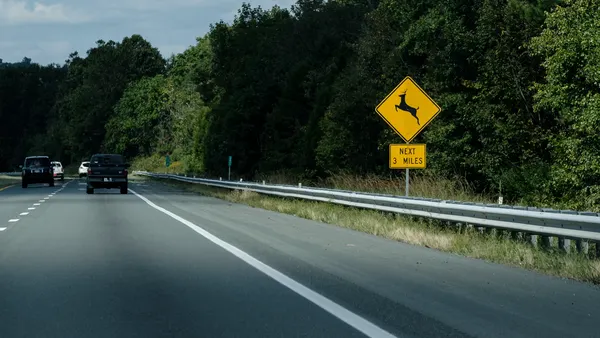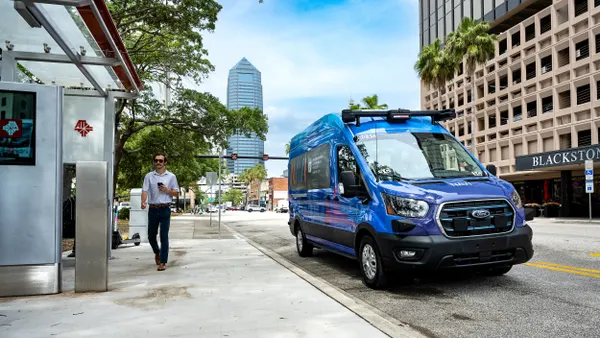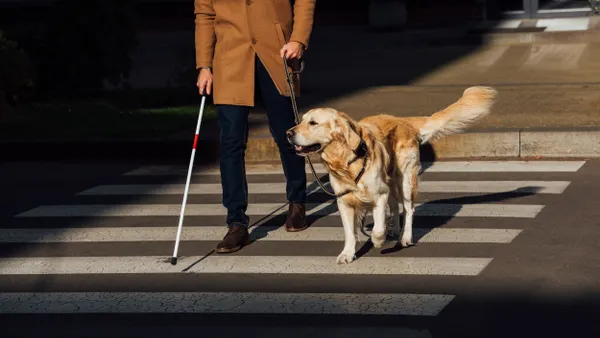UPDATE: The Tempe Police Department released a dashcam video on Wednesday that shows the internal and external views of the Uber autonomous vehicle, moments before it collided with a woman crossing the street.
The vehicle's safety driver is shown looking away from the road for a long period of time as the vehicle traveled, then looking up and gasping before the video cuts off. The video also shows the woman, Elaine Herzberg, walking her bike across the dark street just seconds before she was hit. Police say the car did not slow down or swerve as it approached the woman.
Bryant Walker Smith, a law professor at the University of South Carolina who studies AVs, told CNET that the video "strongly suggests a failure by Uber's automated driving system." He suggested that the crash was likely avoidable, and the woman should have been detected by the car's lidar and radar.
The video also raises questions about the safety driver's responsibility in the situation, and if future AV passengers will need to pay close attention to the road despite not physically driving the car.
Dive Brief:
- Tempe, AZ Police Chief Sylvia Moir said a self-driving car operated by Uber and its safety driver were likely not at fault after striking a woman late Sunday night in Tempe, AZ as she attempted to cross the street, the San Francisco Chronicle reports. The woman, later identified as Elaine Herzberg, 49, died from her injuries.
- A preliminary investigation found that Herzberg walked from a center median into a lane of traffic outside a crosswalk, and the autonomous vehicle (AV) struck her while traveling at 38 mph in a 35 mph zone, the Chronicle reports. The weather was clear at the time of the incident, according to Times reporter Daisuke Wakabayashi.
- Uber is reportedly "fully cooperating" with local authorities to investigate. The company has suspended testing of its AVs in Tempe, Pittsburgh, San Francisco and Toronto.
Our hearts go out to the victim’s family. We’re fully cooperating with @TempePolice and local authorities as they investigate this incident.
— Uber Comms (@Uber_Comms) March 19, 2018
Dive Insight:
This incident is believed to be the first known fatality involving the testing of an autonomous vehicle on public roads. And while the preliminary investigation suggests the Uber and its safety driver are not at fault, this worst-case scenario illustrates concerns many have long expressed regarding AVs — most notably, what could happen if the vehicle encounters an object or person in the road with little detection time.
Moir told the Chronicle that “it’s very clear it would have been difficult to avoid this collision in any kind of mode (autonomous or human-driven) based on how she came from the shadows right into the roadway,” based on video recordings from the AV’s cameras. The AV had at least two cameras fitted: one facing forward and other inside the car.
Policymakers and AV testers often tout statistics that 94% of vehicle crashes are tied to human error, though there is clear evidence that humans are not the only problem. Cornell University professor Bart Selman says this incident underscores the need for additional AV technologies, noting that the vehicles "may need a better ability to integrate information from different sensors."
"For example, the vision system of the car may miss a crucial aspect, such as a pedestrian unexpectedly crossing the road, but at that point, other sensors such as lidar for object detection should overrule the vision system and takes action to avoid a collision," he said in an emailed statement. "That technology is feasible but requires further work."
Arizona has been identified as a favorable state for AV testing due to its dry weather, good roads and density. And though Gov. Douglas A. Ducey recently passed an executive order to advance AV testing and operation and "prioritize public safety," Arizona has had a fairly hands-off approach to AVs. Following this incident, and investigations by the National Transportation Safety Board and the National Highway Traffic Safety Administration (NHTSA), it is likely more regulation will be presented on the state level to further prevent this from happening again.
On Monday, a coalition of more than 25 organizations signed a letter calling for more AV oversight from the federal level, noting the U.S. Department of Transportation and the NHTSA "have chosen to be detached spectators instead of engaged safety regulators during one of the most crucial and critical times in the history of automobiles." Though this incident was not cited in the letter, it is expected that these signatories — including representatives from the Vision Zero Network and Advocates for Highway and Auto Safety — will refer to this occurrence in their efforts to spur more engagement from federal policymakers.










